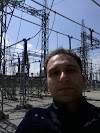I think the best analogy for reactive power and related reactive energy, which is generally expressed as a concept that needs to be gotten rid of, is the wheelbarrow aa rather than beer foam. Lifting the wheelbarrow by holding its arms represents reactive power, and pushing it to move represents active power. It is not very easy to push the wheelbarrow without reactive power, that is, without lifting it. There must be reactive power in the network.
Reactive power is divided into inductive reactive capacitive reactive power. Storing energy as a magnetic or electric field, that is, consuming reactive power, is called inductive reactive, and giving reactive power or producing reactive power by releasing the stored energy is called capacitive reactive. Transformers and motors are inductive loads and draw inductive reactive power because energy is needed to create a magnetic field.
Reactive power:
\[Q = {V_{rms}}{I_{rms}}\sin \varphi \]
Current:
\[i(t) = {I_{\max }}cos(\omega t) \]
The voltage of inductor or coil:
\[{v_L}(t) = L\frac{{di(t)}}{{dt}} = - L\omega {I_{\max }}\sin (\omega t)\]
The stored magnetic energy in an inductor
\[ {W_L}(t) = \frac{1}{2}Li{(t)^2} = \frac{1}{2}LI_{\max }^2{\cos ^2}(\omega t) \]
With the cosine expression, this energy changes sinusoidally and periodically. Maximum value of stored magnetic energy:
\[{W_{L,{\rm{max}}}} = \frac{1}{2}LI_{\max }^2\]
Inductive reactance:
\[{X_L} = \omega L = 2\pi fL\]
Instantenous power:
\[{p_L}(t) = {v_L}(t) \cdot i(t) = - L\omega {I_{\max }}\sin (\omega t) \cdot {I_{\max }}\cos (\omega t) = - \frac{1}{2}L\omega I_{\max }^2\sin (2\omega t)\]
Mean reactive power:
\[{Q_L} = {\left( {\frac{{{I_{\max }}}}{{\sqrt 2 }}} \right)^2} \cdot \omega L = \frac{{I_{\max }^2\omega L}}{2} = I_{{\rm{rms}}}^2 \cdot {X_L}\]
\[\sin \varphi = 1\]
\[{Q_L} = {V_{{\rm{rms}}}}{I_{{\rm{rms}}}}\]
Coil voltage:
\[{V_{{\rm{rms}}}} = {I_{{\rm{rms}}}} \cdot {X_L}\]
\[{Q_L} = I_{{\rm{rms}}}^2 \cdot {X_L}\]
The reactive power of the coil or inductor is proportional to the energy storage rate due to the frequency component, and since it has a positive sign, it draws reactive energy.
The capacitor stores energy in the electric field, and this energy is related to the time-dependent change of voltage.
\[v(t) = {V_{\max }}\cos (\omega t)\]
The current of capacitor:
\[{i_C}(t) = C\frac{{dv(t)}}{{dt}} = - C\omega {V_{\max }}\sin (\omega t)\]
Time dependent energy in capacitor
\[{W_C}(t) = \frac{1}{2}Cv{(t)^2} = \frac{1}{2}CV_{\max }^2{\cos ^2}(\omega t)\]
Maximum energy:
\[{W_{C,{\rm{max}}}} = \frac{1}{2}CV_{\max }^2\]
Capasitive reactance:
\[{X_C} = \frac{1}{{\omega C}} = \frac{1}{{2\pi fC}}\]
Time dependent instantaneous power
\[{p_C}(t) = v(t) \cdot {i_C}(t) = {V_{max}}\cos (\omega t) \cdot ( - C\omega {V_{\max }}\sin (\omega t)) = - \frac{1}{2}C\omega V_{\max }^2\sin (2\omega t)\]
\[- \frac{1}{2}C\omega V_m^2\sin (2\omega t) = - \frac{1}{{2{X_C}}}V_{\max }^2\sin (2\omega t)\]
\[{Q_C} = - \frac{{V_{{\rm{rms}}}^2}}{{{X_C}}}\]
It gives capacitive reagent due to negative sign.
An induction motor draws reactive power to create a rotating magnetic field between the stator and rotor. The stator windings have an inductive impedance to produce magnetic flux, causing the current to lag the voltage (phase difference). The current passing through the stator windings creates a rotating magnetic field and produces mechanical energy by rotating the rotor.
The stator inductance consumes reactive power to create the magnetic field.
\[{Q_L} = I_{{\rm{rms}}}^2 \cdot {X_L}\]
Transformers draw magnetization current to create magnetic flux in the core, which creates reactive power consumption. It is inductive due to winding inductance. Magnetization current creates reactive power.
\[{Q_m} = \frac{{{V_{primer}}^2}}{{{X_m}}} = \frac{{{V_{primer}}^2}}{{\omega {L_m}}}\]
Without reactive energy, the transformer cannot create magnetic flux and cannot bring the voltage to the desired level because there is no secondary voltage.
In the grid, reactive power is drawn and the voltage is reduced by using an inductor or reactor for voltage regulation or current limitation. In grids, especially in long transmission lines or light load conditions, voltage increases may occur due to the capacitive effect of the lines (Ferranti effect). Shunt reactors reduce the voltage by absorbing this excess capacitive reactive power. Series reactors limit short circuit currents while increasing the line impedance to the series reactor, which draws reactive power, and controls the power flow.
\[{Z_{{\rm{toplam}}}} = R + j{X_L}\]
\[P = \frac{{{V_1}{V_2}\sin (\delta )}}{{\mid Z\mid }}\]
Increased reactance reduces active power and prevents loading.
Reactive power increases the voltage stability of the system by preventing voltage drops in the grids. For example, capacitor banks or synchronous compensators are used to keep the inductive voltage level constant on long transmission lines. Voltage drop (V decrease) in the grid can lead to energy losses and equipment failures by simply affecting MWh=VI.h and current. In solar panels or wind turbines, inverters can support the grid voltage by providing reactive power.
Type 1: Constant Speed, Asynchronous Generator wind turbine draws reactive power for rotor magnetism. In Type 2 (WRIG), external resistors reduce the need for reactive power slightly, but draw reactive power. In Type 3 (DFIG), reactive power production or consumption can be controlled thanks to power electronics. It can draw reactive power under high load or low voltage conditions. Type 4 (PMSG/WRSG) can provide reactive power with power electronics.





Social Plugin